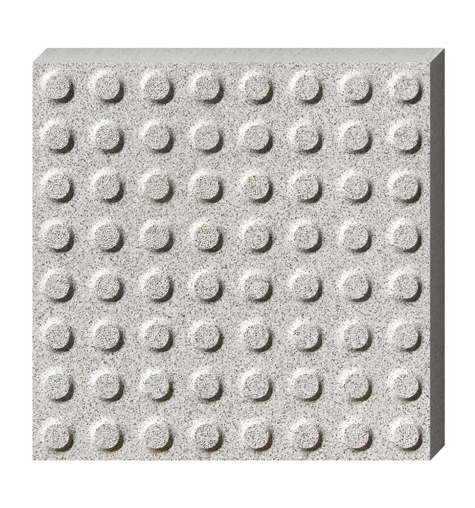|
In the realm of inclusive urban design and accessibility - focused architecture, tactile indicator tiles have emerged as a crucial and innovative solution. These tiles are specifically designed to assist visually impaired individuals, providing them with navigational and safety - related information through touch.

1. Design and Structure
1.1 Tactile Elements
Tactile indicator tiles are characterized by their distinct raised patterns. The most common tactile elements include small rounded bumps and long, narrow ridges. The rounded bumps, often arranged in a specific pattern, are used to indicate a location where a significant change is about to occur, such as the start of a pedestrian crossing or the edge of a platform. These bumps are small enough not to cause discomfort when stepped on but are easily distinguishable by the foot or a cane.
The long, narrow ridges are typically used to guide the visually impaired along a particular path. They create a continuous tactile cue that can be followed, whether it's leading to an entrance, an elevator, or a restroom. The height and spacing of these ridges are carefully calibrated. They are high enough to be felt clearly but low enough so as not to trip up sighted individuals or those without a need for the tactile guidance.
1.2 Material Selection
These tiles are usually made from durable materials. Ceramic is a popular choice due to its hardness, resistance to wear and tear, and ability to maintain the integrity of the tactile patterns over time. Porcelain, with its high - density and smooth finish, is also commonly used. It not only provides a stable surface for the tactile elements but also offers good resistance to water, which is essential for outdoor applications. In some cases, rubber - based materials are used for their shock - absorbing properties and flexibility, especially in areas where there may be a higher risk of impact, such as near escalators.
2. Function and Significance
2.1 Navigational Aid
One of the primary functions of tactile indicator tiles is to act as a navigational aid. In a complex urban environment like a busy city street or a large shopping mall, they help visually impaired people find their way around. For example, along a sidewalk, the tiles can be used to mark the route to a crosswalk. They can also guide individuals to important destinations within a building, such as the reception area, information desks, or emergency exits. By following the tactile cues, visually impaired people can move more independently and with greater confidence.
2.2 Safety Indication
Tactile indicator tiles play a vital role in safety. At train and subway stations, they are used to mark the edge of the platform. The distinct pattern of the tiles alerts visually impaired passengers to the proximity of the platform edge, reducing the risk of falling onto the tracks. In addition, they are used at the top and bottom of stairs, providing a clear indication of the change in elevation. This is crucial for preventing accidents, especially in areas with high foot traffic.
2.3 Psychological Impact
Beyond their practical functions, tactile indicator tiles also have a positive psychological impact on the visually impaired. They give them a sense of control and independence. Knowing that they can rely on these tiles to navigate through public spaces empowers them to engage more fully in social and daily activities. It reduces the feelings of isolation and dependence that can often be associated with visual impairment.
3. Application Scenarios
3.1 Public Transportation
Tactile indicator tiles are extensively used in public transportation facilities. In addition to platform edges, they are also found in subway and train stations' corridors, guiding passengers to ticket booths, turnstiles, and different train lines. At bus stops, they can be used to mark the waiting area and the location where the bus door will open. This ensures that visually impaired passengers can access public transportation safely and efficiently.
3.2 Public Buildings
In public buildings such as hospitals, libraries, and government offices, tactile indicator tiles are used to improve accessibility. They can be used to direct people to different departments, restrooms, and elevators. In hospitals, for example, they can guide patients and visitors to the emergency room, clinics, and waiting areas. This is especially important in large and complex buildings where finding the right way can be challenging even for sighted individuals.
3.3 Pedestrian Walkways
On pedestrian walkways, tactile indicator tiles are used to mark crosswalks, intersections, and the boundaries of the walking path. They help visually impaired pedestrians to safely cross the road and stay on the designated walking route. In some cases, they are also used to mark areas where there may be construction or obstacles, alerting pedestrians to potential hazards.
4. Installation and Maintenance
4.1 Installation
Proper installation of tactile indicator tiles is crucial for their effectiveness. The surface on which they are installed must be clean, dry, and level. Special adhesives are used to ensure a strong bond between the tiles and the substrate. When installing tiles in areas with high foot traffic, such as subway stations, additional measures may be taken to ensure their stability. The alignment of the tactile patterns also needs to be carefully controlled to provide a continuous and clear tactile cue.
4.2 Maintenance
Regular maintenance of tactile indicator tiles is necessary to keep them in good working condition. They need to be cleaned regularly to remove dirt, debris, and any substances that may obscure the tactile patterns. In case of damage, such as chipped or broken tiles, they should be replaced promptly. Periodic inspections should be carried out to ensure that the tiles are still providing the intended navigational and safety information.
|